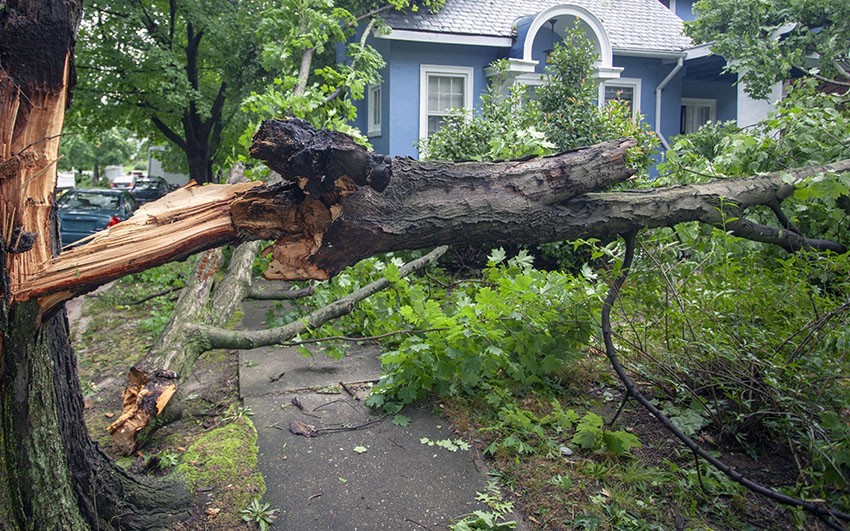Trees not only beautify your home but healthy, well-cared-for trees can also increase the value of your property. However, if a tree or large branch falls it can potentially cause damage, personal injury, or at the very least create a mess that no one will be eager to deal with.
So after a tree falls, who is responsible for the cost of everything? Who is liable in the event a tree falls and damages property or injures someone? Does your neighbor need to have a fallen tree removed, or do you?
Read on to find out.
Who is Liable for a Fallen Tree?
There are a few things to keep in mind before you can determine who is liable for covering the costs of damage caused by a fallen tree and its removal:
Why Did the Tree Fall?
There are many factors that can contribute to a tree falling, and while some are simply out of our control, other instances of tree failure are completely avoidable with proper care.
- Natural Causes: These include various environmental phenomena, such as high winds, snowstorms, hurricanes, or any other natural and unavoidable events.
- Negligence: This can refer to any instance where a tree was not properly cared for. This can include not properly trimming or pruning the branches, ignoring the signs of a pest infestation, or failing to ensure the tree is not sick or diseased.
Whose Tree is It?
If you live in close proximity to your neighbors, or if there are a number of trees in the surrounding landscape it might not be completely obvious who the tree actually belongs to.
- Yours: Any tree trunk that grows within the boundary lines of your property is considered your tree. No matter how much of the tree grows onto your neighbor’s property, if the trunk is rooted on your land, it is your property.
- Your Neighbor: If the tree trunk is rooted within the boundaries of your neighbor’s property, then the tree belongs to them.
- Shared: If the trunk of a tree grows directly on the property line, or in between the two properties as a “boundary tree”, both you and your neighbor share ownership and responsibility of the tree.
Will My Homeowners Insurance Cover Fallen Trees?
While it will inevitably fall on the discretion of the insurance company, there are a few factors that can affect if your homeowner’s insurance will cover the costs associated with a tree falling on your property:
- You’re Covered: If the tree fell due to natural causes, yes your homeowner’s insurance will likely cover the cost of removal and damage. If a tree from either your property or your neighbor’s property falls due to natural causes resulting in damage to a shared fence, your homeowner’s insurance will typically cover 50% while your neighbor’s insurance covers the remaining 50%.
- Not Covered: If the tree fell due to negligence such as lack of care and maintenance, no your homeowner’s insurance will likely not cover any costs associated with clean-up, removal, or repairs.
Who is Responsible if a Neighbors Trees Falls Onto My Property?
Again, there can be a number of factors that affect how situations like this should be handled. Luckily, in most situations, determining who is responsible is pretty straightforward:
- Your Responsibility: If unavoidable circumstances lead to a tree from your neighbor’s property falling onto yours it is your responsibility to have the tree removed. You will need to contact your homeowner’s insurance but they will likely cover all the costs associated with any of the aftermath.
- Your Neighbor’s Responsibility: If a tree falls onto your property due to your neighbor’s negligence, they will be held liable for damages and be responsible for any costs associated with having it removed.
Who is Responsible if a Tree on Public Land Falls on My Property?
If a tree from a nearby park, or otherwise public land, falls on your property, community officials are responsible for having the tree removed and all the costs associated with its removal. However, you will likely need to rely on your homeowner’s insurance policy to cover the costs associated with fixing any damages.
Can I Remove a Fallen Tree Myself?
No. Tree removal is one of the riskiest tasks to undertake if you lack proper training and experience. While a DIY attitude may seem tempting, successfully removing a tree is a complex procedure that requires in-depth training, specialized equipment, and proper licensing.
If you try to remove a tree on your own, or if you hire a person without the proper licensing instead of a professional arborist, you will be held personally liable for any damage or injury resulting from the removal, transportation, or disposal of the tree.
Contact the Certified Arborists at Vintage Tree Care for Tree Removal Services
When determining who is responsible for a fallen tree you will need to consider what caused it to fall and who the tree belongs to. The best way to avoid the hassle of dealing with tree failure is to work with a tree care professional to ensure the health, safety, and beauty of your property for years to come.
If you are concerned about the possibility of a tree falling on your property, or you are looking for tree removal services in Sonoma County contact the certified arborist at Vintage Tree Care.



